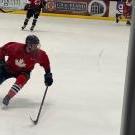

PUCKSTOPPROSHOPJL
-
Content Count
21 -
Joined
-
Last visited
-
Days Won
1 -
Feedback
N/A
Everything posted by PUCKSTOPPROSHOPJL
-
From
NICLAS ROSENHOLM
at PROSHARP
Hi Joseph,
PUCKSTOPPROSHOP
Franklin Pirelli Rink
910 Panthers Way
Franklin, MA 02038
We can't provide the two for the different elliptical shapes as that would be to give away the recipe to the secret sauce.
We can say this about the different profiles without giving away the parameters :
Ellipse Zero – Elliptic value closest to zero (a circle) – also meaning it’s the shortest profile of them all. Currently making it the most agile in the series, while packing the dynamic punch that all Ellipse profiles do. We've taken inspiration from the Quad Zero on this one, making it best suited for skate sizes 7-8 (only a recommendation).
Ellipse I – The in-betweener. Best suited for skate sizes 9-10 (only a recommendation).
Ellipse II – Elliptic level furthest away from zero. Meaning it’s longer, making it more powerful, but still agile. Best suited for skate sizes 11-12 (only a recommendation).
The key feature is the seamlessness of the profiles. This gives the skater the feeling that they always have the optimal ice contact for each on-ice action.
All Ellipse templates are built in with a pitch (-20 mm), good to know when re-profiling an already pitched blade.
More information will be launched later 😊

